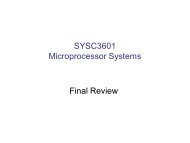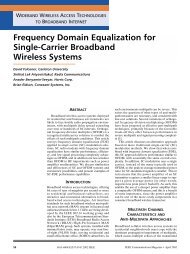Image Reconstruction for 3D Lung Imaging - Department of Systems ...
Image Reconstruction for 3D Lung Imaging - Department of Systems ...
Image Reconstruction for 3D Lung Imaging - Department of Systems ...
You also want an ePaper? Increase the reach of your titles
YUMPU automatically turns print PDFs into web optimized ePapers that Google loves.
while the lung conductivity (σL) was varied. Simulation data were calculated to model the<br />
EIT difference measurements due to introduction <strong>of</strong> a small tidal volume (∆V ) at different<br />
levels <strong>of</strong> baseline σL. Since the relationship between σL and lung volume (VL) is not precisely<br />
known in vivo [94], we model lung conductivity as inversely proportional to VL. For a small<br />
∆V we make the following approximation:<br />
σL<br />
σ =<br />
1 + ∆V/VL<br />
≈ σLe −∆V /VL<br />
Using this approximation, tidal volume, ∆V , constitutes a constant decrease in log conductivity.<br />
Difference measurements are simulated <strong>for</strong> inspiration and expiration as:<br />
vinsp = F(σLe −∆V /VL )<br />
vexp i = F(σL)<br />
Simulations were conducted <strong>for</strong> ∆V/VL = 10% over a range <strong>of</strong> 20 values from 5 mS/m to<br />
2000 mS/m. This large non-physiological range was simulated in order to clarify the trend<br />
<strong>of</strong> the results. The reference frame was taken at the background lung conductivity.<br />
A.2.3 Evaluation Procedure<br />
Six sets <strong>of</strong> reconstructions were calculated using a 1968 element 2D finite element model.<br />
<strong>Image</strong>s were reconstructed from the simulated data and using three different reconstruction<br />
algorithms: 1) using a homogeneous σ0, 2) using σ0 with physiological values and σ0 at its<br />
inspiration value (60 mS/m) (∆VEIT,Inspi), and 3) using σ0 with physiological values and<br />
σL matching σL that was used to simulate the data ∆VEIT,Simul. In the third algorithm<br />
the area <strong>of</strong> the non-homogenous region, AσL <strong>of</strong> the FEM was varied; thus four sets <strong>of</strong><br />
reconstructions were calculated with areas <strong>of</strong> AσL = 33%, AσL = 51%, AσL = 73%, and<br />
AσL = 86% as shown in figure A.2. Thus the single set <strong>of</strong> 20 simulated measurements was<br />
used to reconstruct six sets <strong>of</strong> 20 images.<br />
An EIT estimate <strong>of</strong> tidal volume, ∆VEIT, was then calculated by summing all pixels <strong>of</strong><br />
the 2D FEM weighted by the pixel’s area. ∆VEIT = E�<br />
Aiσi where Ai is the area/volume<br />
<strong>of</strong> element i and σi is the conductivity <strong>of</strong> element i.<br />
A.3 Results<br />
Figure A.3 shows four plots <strong>of</strong> image amplitude vs baseline lung conductivity, σL, <strong>for</strong> each<br />
algorithm. The different subplots correspond to non-homogenous Jacobians <strong>of</strong> differing<br />
area. The two curves <strong>for</strong> the homogenous Jacobian algorithms (blue and black lines) are<br />
the same in each <strong>of</strong> the subplots.<br />
The results <strong>for</strong> ∆VEIT −Homo (black curve) are consistent with those <strong>of</strong> Kunst et al<br />
[83]. <strong>Image</strong> amplitude <strong>for</strong> the same proportional volume change increases dramatically with<br />
increasing baseline (starting/initial) lung conductivity; there is a large increase in image<br />
amplitude as σL increases from 60 mS/m to 120 mS/m. Use <strong>of</strong> constant but physiologically<br />
realistic values reduces the dependence only slightly (blue curve). The use <strong>of</strong> parameters<br />
that match the simulation (red curve) results in significant decrease in the dependence on<br />
σL. However the effect is strongly dependent on the area <strong>of</strong> the inhomogeneity <strong>of</strong> the reconstruction<br />
mesh used to calculate the Jacobian. Figure 8.3(a), in which the inhomogeneous<br />
area, Aσˆ L is 33%, shows a strong dependence on σL <strong>for</strong> σL < 120 mS/m but becomes<br />
121<br />
i=1





